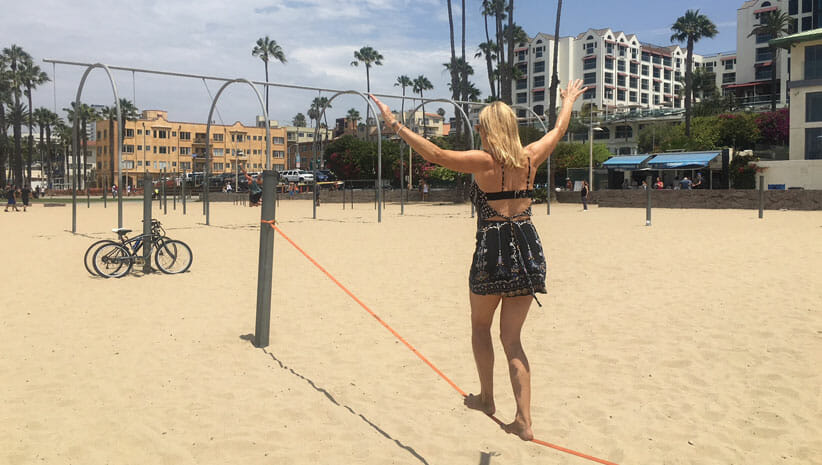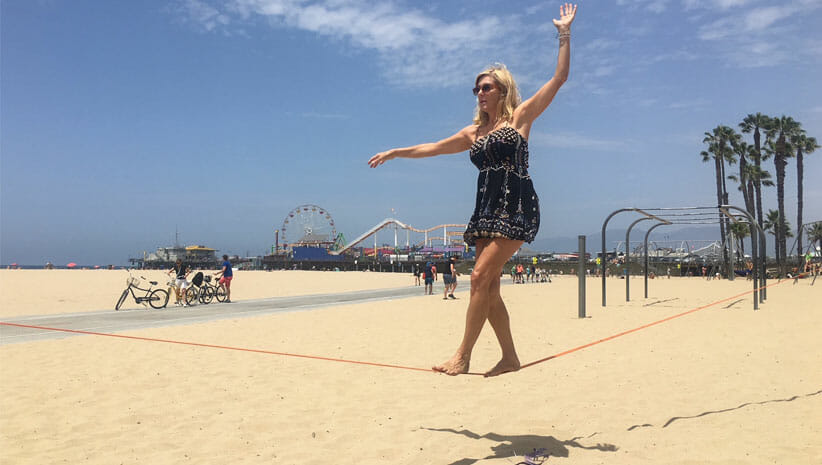Walk the Line: Slacklining
If you’ve ever thought about running off to join the circus to enjoy the thrill of walking a tightrope like a Wallenda, you might be intrigued by the outdoor sport of slacklining. It is a challenging practice accessible to beginners that offers a method for connecting mental focus, breath, and embodied practice.
Slacklining is a moving meditation that strengthens your ability to concentrate and cultivates your ability to balance. Even without practicing fancy poses on the line, slacklining is an embodied practice of yoga.
What is Slacklining
A slackline is a sturdy synthetic webbed strap, one or two inches thick, that is hung between two trees or poles at various tensions, heights, and distances. The concept is similar to tightrope walking, but there is give (slack) in the line, so no balance pole is required. West Coast-based rock climbers originally co-opted the sport from the circus in the 1980s. Slacklining has grown into a worldwide sport, with tricks and extreme feats. Yet, the basic practice is a hobby that can be great cross-training as well as an integrated yoga practice.
Slacklining on Muscle Beach in Santa Monica
I first tried slacklining at the impressive and creative Original Muscle Beach on the Santa Monica boardwalk, where people seem to recreate circus acts on the sand for their own enjoyment. A community of work-out enthusiasts gather here to challenge themselves in various unique ways (progressive rings, rope climbing, acroyoga) and have fun.
At the south end of Muscle Beach, the City of Santa Monica created a slackline park simply by installing some dozen solid tall posts. Slackliners bring their own lines and set them up at various heights and lengths. Advanced slackers will often set up an easier slackline nearby for beginners who approach and want to give it a try.
Balancing on a Slackline
Whenever someone steps on a slackline for the first time, their leg bent up on the line will shake and shake and shake, as will the slackline — sometimes tremendously. Even with one foot still on the ground. Once they stand up and hold on to the shoulder of a friend, they feel the sense of balance and the wonderful potential experience of slacklining. But when they try to stay up on their own, the first-timer inevitably asks, “When will the shaking ever end?” After all, people are balancing on a swaying surface!
Looking back, I don’t remember exactly when my shaking subsided, but I do remember I was determined to become steady and take some steps. After repetition, I was able to balance and walk the length of the line. Now that I’ve been at it for some time, if I go even a week without slacklining, I start yearning for the release I feel when I am up on the line. My feet love the pressure-point tension, and my body craves the relaxation when I am balanced and walking above the ground.

Balance and Meditation on a Slackline
I’ve always been attracted to balance activities such as roller skating, rollerblading, skateboarding, figure skating, snowboarding, and stand up paddle boarding. While I have not necessarily excelled at these activities, I have always found them appealing and satisfying.
As I learned to slackline, I experienced the additional benefit of the meditative experience. Slacklining is a moving meditation. You must be present when you walk on a slackline. In order to balance, you first need to stop looking down (what?!) then find an eye-level focal point in the near distance (drishti) and loosely keep your attention there. Then, lower your center of gravity and breathe. The calmer you are and less distracted you are, the longer you will stay on the line.
Take it One Step at a Time
Of course, there is a learning curve, and it’s often steep! Improvements in skill, even micro-improvements, come from conquering your nerves. As a beginner, take it one step at a time (pun intended). To walk, first balance on two feet for a few seconds, then balance with just one foot on the slackline, then try to put one foot in front of the other. For more stability, choose shorter slacklines that are closer to the ground.
While walking on the line requires skill, balance, and concentration, there are other dramatic slacklining practices that are popular throughout the world. These include yoga poses, tricklining, longlining, highlining (over elevations like a canyon), and waterlining ( over a body of water including a pool). a The maneuvers in tricklining resemble snowboarding halfpipe tricks: extreme air flips, twists and rotations. Both tricklining and longlining are performed at the Muscle Beach Santa Monica.
Equipment and Finding Community
As a novice, I started out on a two-inch basic Gibbon line (the most common brand) and eventually switched to a one-inch “yoga” line after trying it out at a festival. For me personally, the one-inch slackline gives me greater stability. I can wrap my feet on the sides of it and it even feels like foot reflexology.
At first, I practiced on other people’s lines, then I invested in my own equipment. You can buy a basic beginner slackline for about $35 from retailers specializing in outdoor equipment. YogaSlackers sells gear (I purchased their $90 eline), as does REI, as well as online outlets. You can set up a line (with towels as tree protectors) between two trees.
If you stop by the slackline park at Muscle Beach Santa Monica, you may find dozens of slacklines set up at various heights, lengths, and tensions between the sets of poles. Ask to try one of the shorter, lower lines already set up. I find that slackers are, by and large, kind and generous teachers.
Advice from Slackliners
Repeat a mantra: ‘Breathe, step,’ and say it out loud as you move.
Be sure to smile — it relaxes the face.
Public parks, festivals, and classes are only a few of the places where people share tips and techniques. Of course, you can find plenty of info online.
YogaSlackers Beginner Class
YogaSlackers has a beginner class on YouTube.
Read More about YogaSlackers
Read more about YogaSlackers, including advice from YogaSlackers teacher Raquel Hernandez-Cruz.
From Balance to Steadiness while Slacklining
The character we build by practicing our ability to find balance on a flexible line, strung above the earth, can help us experience greater steadiness when it comes time to standing on solid ground. And after all, that’s what we need most – balance and calm in our lives.
Karen Henry is an Associate Editor at LA YOGA who volunteers in a variety of capacities for nonprofit organizations and artists around Los Angeles. She practices yoga as a counterbalance to her daily impact sports and is a mother of four grown children who also practice yoga . Now, she’s working on teaching yoga and joy of life to the grandkids!

